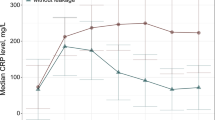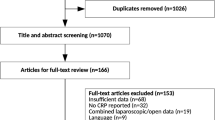Abstract
Background
Nowadays, most patients who undergo colorectal surgery are discharged early. An early predictor of septic complications could avoid readmissions and decrease morbidity. CRP could be a good predictor allowing a safe discharge.
Methods
A prospective, observational study was conducted from November 2007 to October 2008. All patients who underwent elective colorectal surgery were included. Clinical (temperature, pulse, abdominal tenderness, bowel movements) and laboratory data (C-reactive protein, leukocyte count) were recorded and evaluated as early predictors of septic complications (namely, anastomotic leaks). All detected leaks were considered fistulas, independently of their clinical significance. Clinical and inflammatory parameters were analyzed with univariate and multivariate techniques; logistic regression was performed and areas under the receiver operating characteristic curve were compared.
Results
A total of 133 patients were included. The overall incidence of anastomotic leaks was 15.5% and mortality was 4.5%. C-reactive protein at postoperative days 2 and 4 was a good predictor of anastomotic leak (areas under the curve were 0.715 and 0.845, respectively) and other postoperative septic complications (areas under the curve were 0.804 and 0.787), showing the highest accuracy among clinical and laboratory data. A cutoff of 125 mg/l in the level of C-reactive protein at postoperative day 4 yielded a sensitivity of 81.8% and a negative predictive value of 95.8% for the detection of anastomotic leakage.
Conclusions
C-reactive protein is a simple way to ensure a safe discharge from hospital after elective colorectal surgery. Patients with CRP values >125 mg/l on the fourth postoperative day should not be discharged.


Similar content being viewed by others
References
Alves A, Panis Y, Mathieu P, Mantion G, Kwiatkowski F, Slim K et al (2005) Postoperative mortality and morbidity in French patients undergoing colorectal surgery. Arch Surg 140:278–283
Bellows CF, Webber LS, Albo D, Awad S, Berger DH (2009) Early predictors of anastomotic leaks after colectomy. Tech Coloproctol 13:41–47
Kingham TP, Pachter HL (2009) Colonic anastomosis leak: risk factors, diagnosis, and treatment. J Am Coll Surg 208:269–278
Karliczek A, Harlaar NJ, Zeebregts CJ, Wiggers T, Baas PC, van Dam GM (2009) Surgeons lack predictive accuracy for anastomotic leakage in gastrointestinal surgery. Int J Colorectal Dis 24:569–576
Ortega Deballon P, Ruiz de Adana-Belbel JC, Hernandez-Matias A, Garcia-Septiem J, Moreno-Azcoita M (2008) Usefulness of laboratory data in the management of right iliac fossa pain in adults. Dis Colon Rectum 51:1093–1099
Karamarkovic A, Radekovic D, Milic N et al (2005) Protein C as an early marker of severe septic complications in diffuse secondary peritonitis. World J Surg 29:759–765
Mustard RA, Bohnen JM, Haseeb S, Kasina R (1987) C-reactive protein levels predict postoperative septic complications. Arch Surg 122:69–73
Eriksson S, Olander B, Pira U, Granstrom L (1997) White blood cell count, leukocyte elastase activity, and serum concentrations of interleukin-6 and C-reactive protein after open appendectomy. Eur J Surg 163:123–127
Wong VK, Malik HZ, Hamady ZZ, Al-Mukhtar A, Gomez D, Prasad K et al (2007) C-reactive protein as a predictor of prognosis following curative resection for colorectal liver metastases. Br J Cancer 96:222–225
Matthiessen P, Henriksson M, Hallböök O, Grunditz E, Norén B, Arbman G (2008) Increase of serum C-reactive protein is an early indicator of subsequent symptomatic anastomotic leakage after anterior resection. Colorectal Dis 10:75–80
Welsch T, Frommhold K, Hinz U, Weigand MA, Kleeff J, Friess H et al (2008) Persisting elevation of C-reactive protein after pancreatic resections can indicate developing inflammatory complications. Surgery 143:20–28
Welsch T, Müller SA, Ulrich A, Kischlat A, Hinz U, Kienle P et al (2007) C-reactive protein as early predictor for infectious postoperative complications in rectal surgery. Int J Colorectal Dis 22:1499–1507
Deitmar S, Anthoni C, Palmes D, Haier J, Senninger N, Brüwer M (2009) Are leukocytes and CRP early indicators for anastomotic leakage after esophageal resection? Zentralbl Chir 134:83–89
Horan TC, Gaynes RP, Martone WJ, Jarvis WR, Emori TG (1992) CDC definitions of nosocomial surgical site infections 1992: a modification of CDC definitions of surgical wound infections. Infect Control Hosp Epidemiol 13:606–608
Hyman N, Manchester TL, Osler T, Burns B, Cataldo PA (2007) Anastomotic leaks after intestinal anastomosis: it’s later than you think. Ann Surg 245:254–258
Alves A, Panis Y, Trancart D et al (2002) Factor associated with clinically significant anastomotic leakage after large bowel resection: multivariate analysis of 707 patients. World J Surg 26:499–502
Yeh CY, Changchien CR, Wang JY et al (2005) Pelvic drainage and other risk factors for leakage after elective anterior resection in rectal cancer patients: a prospective study of 978 patients. Ann Surg 241:9–13
Montagnana M, Minicozzi AM, Salvagno GL, Danese E, Cordiano C, De Manzoni G et al (2009) Postoperative variation of C-reactive protein and procalcitonin in patients with gastrointestinal cancer. Clin Lab 55:187–192
Novotny A, Emmanuel K, Matevossian E, Kriner M, Ulm K, Bartels H et al (2007) Use of procalcitonin for early prediction of lethal outcome of postoperative sepsis. Am J Surg 194:35–39
Reith HB, Mittelkötter U, Debus ES, Küssner C, Thiede A (1998) Procalcitonin in early detection of postoperative complications. Dig Surg 15:260–265
Dörge H, Schöndube FA, Dörge P, Seipelt R, Voss M, Messmer BJ (2003) Procalcitonin is a valuable prognostic marker in cardiac surgery but not specific for infection. Thorac Cardiovasc Surg 51:322–326
Chromik AM, Endter F, Uhl W, Thiede A, Reith HB, Mittelkötter U (2006) Preemptive antibiotic treatment vs ‘standard’ treatment in patients with elevated serum procalcitonin levels after elective colorectal surgery: a prospective randomised pilot study. Langenbecks Arch Surg 391:187–194
Platell C, Barwood N, Dorfmann G, Makin G (2007) The incidence of anastomotic leaks in patients undergoing colorectal surgery. Colorectal Dis 9:71–79
Korner H, Nielsen HJ, Soreide JA, Nedrebo BS, Soreide K, Knapp JC (2009) Diagnostic accuracy of C-reactive protein for intraabdominal infections after colorectal resections. J Gastrointest Surg 13:1599–1606
Acknowledgments
The authors thank Alain Brachet, M.D. and Claire Chalumeau, M.D. for their help in the follow-up of the patients and Mr. Philip Bastable for the language revision of the manuscript.
Author information
Authors and Affiliations
Corresponding author
Rights and permissions
About this article
Cite this article
Ortega-Deballon, P., Radais, F., Facy, O. et al. C-Reactive Protein Is an Early Predictor of Septic Complications After Elective Colorectal Surgery. World J Surg 34, 808–814 (2010). https://doi.org/10.1007/s00268-009-0367-x
Published:
Issue Date:
DOI: https://doi.org/10.1007/s00268-009-0367-x




